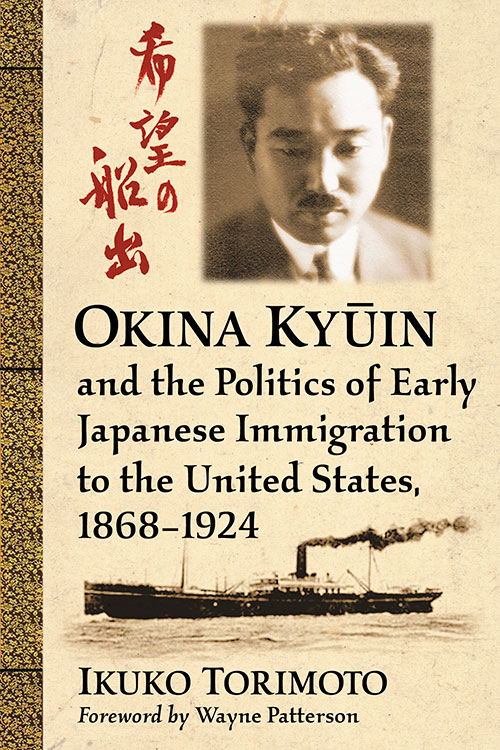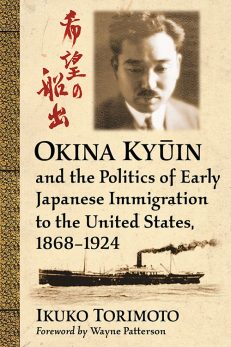Okina Kyūin and the Politics of Early Japanese Immigration to the United States, 1868–1924
$49.95
In stock
About the Book
Okina Kyūin boarded the steamship Kaga Maru at the port of Yokohama in 1907, bound for America. For this ambitious young man, Japanese-American newspapers were an invaluable medium for communicating his opinions on important social issues and documenting everyday life in his community. His vivid articles and stories established him as an essential voice among Japanese immigrants. This book examines Okina’s life on the American West Coast in the context of U.S.–Japanese diplomatic relations between 1868 and 1924.
About the Author(s)
Bibliographic Details
Ikuko Torimoto
Format: softcover (6 x 9)
Pages: 368
Bibliographic Info: 49 photos, appendix, notes, bibliography, index
Copyright Date: 2017
pISBN: 978-1-4766-6433-0
eISBN: 978-1-4766-2734-2
Imprint: McFarland
Table of Contents
Acknowledgments ix
Foreword by Wayne Patterson 1
Preface 3
Part One. Japanese Exploration of the Western World: Early Japanese Visitors to Europe and the Americas 11
1. Date Masamune’s Odyssey: Exploring the Outside World in the Early Edo Period 12
2. Dispatch of Embassies and Students to the West 23
3. Chinese Crossing the Pacific Ocean 29
4. John Henry Schnell Leads the First Japanese Emigrants to North America 33
5. Early Japanese Pioneers in the United States 48
6. Japanese Students in the United States 54
Part Two. Okina Kyūin on the American West Coast, 1907–1924 70
7. Okina Kyūin, an Extraordinary Japanese 71
8. Cultural Journalism on the American West Coast 73
9. Seattle, Washington, 1907–1908 76
10. Nihonjin-machi (Japantown) in Seattle 78
11. Bremerton, 1908–1909 84
12. Japanese-American Newspapers in Seattle 86
13. The End-of-the-Year Dinner: The Zabuton (Japanese Sitting Cushion) Incident 91
14. A Literary Man’s Play 93
15. In Portland and Astoria, 1910–1911 94
16. “Satō no Himitsu” (Satō’s Secret Life Story) 97
17. “Yonkagetsuhan” (Four and a Half Months) 103
18. Aspiration to Write for Japanese-American Newspapers 104
19. Return to Japan, 1913–1914 107
20. Back to Seattle 110
21. Okina and the Furuya Company (1914) 118
22. Life in Stockton (1914–1917) 120
23. Stockton’s Japantown 121
24. Okina’s Wife Arrives in San Francisco 123
25. Shashin Kekkon: Picture Brides 127
26. The Stockton Nihonjinkai (Japanese Association of Stockton) 131
27. Ushijima Kinji, President of the Zaibei Nihonjinkai 132
28. Okina Visits Mizutani Bangoku of the Ōfu Nippō (The Sacramento Daily News) 134
29. Editor of the Ōfu Nippō at Stockton 136
30. “Jun Iminchi Bungaku no Bokkō Jidai” (Time of the Coming of Age of Real Immigrant Literature) 139
31. “Kakeochi” (Runaway) 141
32. “Aku no Hikage” (Shadow of Evil) 142
33. Journalists from Leading Newspaper Companies in Japan 143
34. Florin, 1916–1917 149
35. Life in Oakland, 1917–1924 153
36. Oakland’s Japantown 155
37. Secretary of the Oakland Nihonjinkai (Japanese Association of Oakland) 160
38. Many Visitors 163
39. A Most Distinguished and Influential Japanese American, Abiko Kyūtarō 166
40. Editor of the Nichi Bei (The Japanese American News) 170
41. “Sukesan wa Doko e Iku?” (Where Does Suke-san Go?) 171
42. “Kusareen” (An Unseverable Relationship) 173
43. The Literary Portrayal of Japanese Immigrant Women in the U.S. 177
44. Okina Becomes a Father 185
45. The 1921–1922 Washington Conference 187
46. “Oyagoroshi” (Killing One’s Parents) and “Nihonjin no Ko” (Children of Japanese Parents) 199
Part Three. The Japanese Government’s Policy on Emigration to the United States 207
47. Japanese-American Diplomatic Relations: The First Japanese Consulate 208
48. Early Diplomacy: From the Kanyaku Imin Period to the Annexation of Hawai‘i in July 1898 214
49. Japanese Immigrant Settlements in California, 1885–1907, and the Gentlemen’s Agreement 226
50. The Anti-Japanese Movement in California and the 1913 Alien Land Law 238
51. Further Immigration Bills, 1917–1924, and Continued Negotiations 251
Conclusion 290
Appendix: A Chronology of Okina Kyūin’s Publications 299
Chapter Notes 329
Bibliography 331
Index 345





